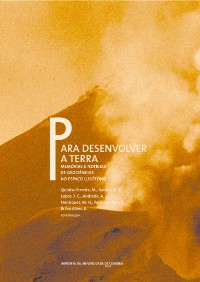Please use this identifier to cite or link to this item:
https://hdl.handle.net/10316.2/31498| DC Field | Value | Language |
|---|---|---|
| dc.contributor.author | Nunes, J. O. R. | |
| dc.contributor.author | Fushimi, M. | |
| dc.contributor.author | Santos, C. A. M. dos | |
| dc.contributor.author | Hasegawa, J. K. | |
| dc.contributor.author | Silva, Q. D. da | |
| dc.date.accessioned | 2014-06-23T14:00:14Z | |
| dc.date.accessioned | 2020-09-18T16:04:17Z | - |
| dc.date.available | 2014-06-23T14:00:14Z | |
| dc.date.available | 2020-09-18T16:04:17Z | - |
| dc.date.issued | 2012 | - |
| dc.identifier.isbn | 978-989-26-0534-0 (PDF) | |
| dc.identifier.uri | https://hdl.handle.net/10316.2/31498 | - |
| dc.description.abstract | Nowadays, the geomorphological map is considered an important tool to landscape research. The landscapes in the study area mainly comprise sedimentary rocks from the Adamantina and Santo Anastacio Formations (IPT, 1981). Geomorphologicallly, reliefs of broad hills with lightly waved tops prevail (NUNES & FUSHIMI, 2010), and pedologically, the soils Latossolos Vermelhos and Argissolos Vermelho Amarelos (OLIVEIRA, 1999) prevail, which in the absence of appropriate management undergone a serious condition of erosive degradations in the study area. So, this works aims to elaborate the geomorphological mapping of the westernmost part of the São Paulo State, Brazil, using digital stereoscopy techniques. TRICART (1965) and ROSS (1992) are the main references used to perform this geomorphological mapping. In order to perform the geomorphological mapping of the aforementioned region the 3D restitution technique by means of ALOS/PRISM images was used. The geomorphological features are extracted by using a mirror stereoscope in front of the computer display, putting the fluctuating marks (measurement) over the point in the stereo-model and transmitting for a draw file that are saved with extensions “v3d” and “vxd”, in the public format from AutoCad (3D), respectively (HASEGAWA, 2010). Some geomorphological features have been digitalized, like river channels, watersheds, the limits between tops and strands from the lightly waved hills. Field works have also been carried out in order to identify soil types, geological formations and erosive features derived from inadequate soil use and occupation | eng |
| dc.description.abstract | O mapa geomorfológico é considerado atualmente como importante instrumento na pesquisa da paisagem. As paisagens da área de estudo são constituídas, na sua maioria, por substrato geológico de rochas sedimentares das Formações Adamantina e Santo Anastácio (IPT, 1981). Geomorfologicamente, predominam os relevos de colinas amplas de topos suavemente ondulados (NUNES & FUSHIMI, 2010), e pedologicamente, os Latossolos Vermelhos e Argissolos Vermelho Amarelos (OLIVEIRA, 1999), que historicamente sem manejo adequado, formaram um sério quadro de degradações erosivas para a área de estudo. Assim, o presente trabalho tem como objetivo elaborar o mapeamento geomorfológico de parte do Extremo Oeste Paulista, utilizando técnicas de estereoscopia digital. Em relação aos procedimentos utilizados na elaboração do mapeamento geomorfológico, as principais referências são TRICART (1965) e ROSS (1992). Para elaboração do mapeamento geomorfológico tem-se aplicado a técnica de restituição – 3D, através das imagens ALOS/PRISM, da região de Presidente Prudente. As feições geomorfológicas são compiladas utilizando um estereoscópio de espelhos na frente do computador, colocando as marcas flutuantes (medição) sobre o ponto no estereomodelo e transmitindo para o arquivo de desenho, que são salvos com extensões “v3d” e “dxf”, no formato público do AutoCad (3D), respectivamente (HASEGAWA, 2010). Até o presente momento, foram digitalizadas algumas feições geomorfológicas, como os canais fluviais, os divisores dágua, e os limites entre os topos e as vertentes das colinas suavemente onduladas. Foram realizados também trabalhos de campo, para identificação dos tipos de solos e formações geológicas, bem como as feições erosivas decorrentes do uso e ocupação inadequados do solo | por |
| dc.language.iso | por | - |
| dc.publisher | Imprensa da Universidade de Coimbra | por |
| dc.relation.ispartof | http://hdl.handle.net/10316.2/24406 | por |
| dc.rights | open access | - |
| dc.subject | Mapping | eng |
| dc.subject | Geomorphology | eng |
| dc.subject | Planning | eng |
| dc.subject | Environment | eng |
| dc.subject | Presidente Prudente-SP (Brazil) | eng |
| dc.subject | Mapeamento | por |
| dc.subject | Geomorfologia | por |
| dc.subject | Planejamento | por |
| dc.subject | Ambiente | por |
| dc.subject | Presidente Prudente-SP (Brasil) | por |
| dc.title | A importância do mapeamento geomorfológico como auxílio ao planejamento ambiental | por |
| dc.title.alternative | The importance of geomorphological mapping as a tool to environmental planning | eng |
| dc.type | bookPart | por |
| uc.publication.firstPage | 473 | - |
| uc.publication.lastPage | 480 | - |
| uc.publication.location | Coimbra | por |
| dc.identifier.doi | 10.14195/978-989-26-0534-0_48 | - |
| uc.publication.digCollection | PB | por |
| uc.publication.orderno | 48 | - |
| uc.publication.area | Artes e Humanidades | por |
| uc.publication.bookTitle | Para conhecer a Terra: memórias e notícias de Geociências no espaço lusófono | - |
| uc.publication.manifest | https://dl.uc.pt/json/iiif/10316.2/31498/218531/manifest?manifest=/json/iiif/10316.2/31498/218531/manifest | - |
| uc.publication.thumbnail | https://dl.uc.pt/retrieve/11294628 | - |
| uc.publication.parentItemId | 52124 | - |
| uc.itemId | 71850 | - |
| item.grantfulltext | open | - |
| item.fulltext | With Fulltext | - |
| Appears in Collections: | Para conhecer a Terra: memórias e notícias de Geociências no espaço lusófono | |
Files in This Item:
| File | Description | Size | Format | |
|---|---|---|---|---|
| 48-para_desenvolver_a_terra_artigo..pdf | 2.33 MB | Adobe PDF |  |
Items in DSpace are protected by copyright, with all rights reserved, unless otherwise indicated.
